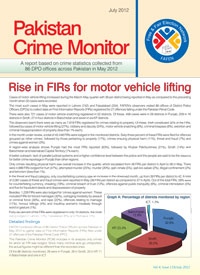ISLAMABAD, June 25, 2012: About one-third posts of female Medical Officers (MOs) were unoccupied in 64 Rural Health Centers (RHCs) across the country, according to a Free and Fair Election Network (FAFEN) report on Monday.
Of the 76 sanctioned posts of female MOs, 53 were occupied leaving 30% of them vacant. Considering the social structure of the country, women patients hesitate to come to the health facilities if there is no female staff.
FAFEN’s monitors, who visited 83 RHCs in April – 49 in Punjab, 19 in KP, eight in Balochistan, six in Sindh and one in FATA – found that the highest occupancy rate of female medical officers was in Balochistan (50%), followed by KP (45%), Sindh (33%) and Punjab (26%).
As for other medical staff, no appointment was made against the sanctioned posts of specialists and ophthalmologists. However, 85% posts of dental surgeons, 87% of male medical officers and 89% of medical officers (Tuberculosis, TB) were filled. On average, the occupancy rate of medical staff was 81%.
The average occupancy rate of technical staff was 78%. It was 91% for paramedical staff and 92% for support staff.
Monitoring of health facilities revealed that Sui gas connections were lacking in 96% RHCs while 46% of them did not have landline telephone connections.
Buildings of 18% health facilities were not in good condition and a similar percentage did not have washrooms with running water. About 16% RHCs did not have residential arrangements for doctors and other staff.
There were proper roads leading to 89% RHCs while 87% of them had boundary walls. Ninety three percent health facilities were found clean with 73% having arrangements for clean drinking water. Electricity connections were available in 92% of the facilities and 93% had fans.
On the general facilities side, 95% RHCs were without ophthalmology rooms and 18% lacked dental rooms. Similarly, 16% had no labour rooms and 11% did not have wards for in-patients.
Moreover, 29% RHCs lacked operation theatres for carrying out minor operations. Fifteen percent did not have x-ray rooms whereas there were no functional x-ray machines in 29% of the health facilities. ECG machines were also not available in 43% RHCs; 19% were without oxygen tents and 18% had no ambulances. Wheelchairs were found lacking in 33% RHCs and 17% did not have stretchers.
However, more than 90% of the total health facilities had delivery kits and syringe cutters whereas 99% of them had medicines.
During the February-April 2012 quarter, 55 visits were made by government/elected officials to the monitored RHCs. Of these, 45 were in Punjab, six in KP, three in Balochistan and one in Sindh. Executive District Officer Health made the most visits (27), while some other government officials visited the facilities 21 times.
One visit was made by a Member Provincial Assembly in Khyber Pakhtunkhwa. Other elected representatives made six visits, all of them in Punjab.



